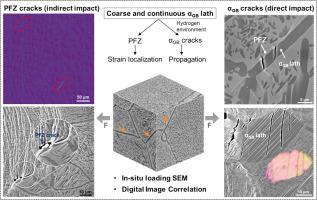On the origin of grain boundary α phase mediated strain localization and crack initiation in metastable β titanium alloy
IF 9.3
1区 材料科学
Q1 MATERIALS SCIENCE, MULTIDISCIPLINARY
引用次数: 0
Abstract
Grain boundary α (αGB) phase and adjacent precipitate-free zones (PFZs) in metastable β titanium alloys are critical microstructural features that govern strain localization and crack initiation, yet their synergistic roles in mechanical degradation remain inadequately understood. In this study in-situ mechanical testing coupled with microstructural strain mapping by high-resolution digital image correlation (HRDIC) were employed to elucidate the interplay between PFZ-mediated strain localization and plasticity of αGB in an additive-manufactured metastable β titanium alloy. Results from in-situ tensile tests revealed that premature cracking of αGB occurs at the incipient plasticity, and PFZs act as preferential pathways for rapid crack propagation, which dramatically reduces the ductility of the alloy. Hydrogen content analysis and lattice strain measurement demonstrated that the adsorption of surface hydrogen during sample preparation in a hydrous environment embrittles the αGB. By substituting the preparation method with hydrogen-free ion milling, αGB cracking is eliminated; however, strain localization in PFZs persists, enabling crack initiation at a later stage of plasticity. Crystallographic analyses demonstrated that slip systems with high Schmid factors in β phase regions adjacent to αGB lamellae drive strain localization magnitudes up to two orders higher than far-field strains. These findings reveal a dual detrimental role of αGB lamellae: promoting PFZ formation and strain localization, and serving as hydrogen-sensitive crack nucleation sites. This work further indicates that hydrogen intake during processing and service could largely alter the character of αGB under loading and affect the performance of metastable titanium alloys in demanding environments.

亚稳β钛合金晶界α相介导的应变局部化和裂纹萌生的起源
亚稳β钛合金的晶界α (α gb)相和邻近的无析出区(PFZs)是控制应变局部化和裂纹萌生的关键组织特征,但它们在力学退化中的协同作用尚不清楚。本研究采用原位力学测试和高分辨率数字图像相关(HRDIC)显微组织应变映射技术,阐明了pfz介导的应变局部化与增材制造亚稳态β钛合金αGB塑性之间的相互作用。原位拉伸试验结果表明,αGB在塑性初期发生过早裂纹,pfz是快速裂纹扩展的优先路径,显著降低了合金的塑性。氢含量分析和晶格应变测量表明,在含水环境下制备样品时,表面氢的吸附使αGB脆性。用无氢离子铣削代替制备方法,消除了αGB开裂;然而,pfz中的应变局部化仍然存在,使得塑性后期的裂纹萌生成为可能。晶体学分析表明,邻近αGB片层的β相区具有高施密德因子的滑移系统使应变局部化幅度比远场应变高两个数量级。这些发现揭示了αGB片层的双重有害作用:促进PFZ的形成和应变局部化,并作为氢敏感的裂纹成核位点。研究进一步表明,加工和使用过程中的氢气摄入会极大地改变αGB在载荷下的特性,影响亚稳态钛合金在苛刻环境中的性能。
本文章由计算机程序翻译,如有差异,请以英文原文为准。
求助全文
约1分钟内获得全文
求助全文
来源期刊

Acta Materialia
工程技术-材料科学:综合
CiteScore
16.10
自引率
8.50%
发文量
801
审稿时长
53 days
期刊介绍:
Acta Materialia serves as a platform for publishing full-length, original papers and commissioned overviews that contribute to a profound understanding of the correlation between the processing, structure, and properties of inorganic materials. The journal seeks papers with high impact potential or those that significantly propel the field forward. The scope includes the atomic and molecular arrangements, chemical and electronic structures, and microstructure of materials, focusing on their mechanical or functional behavior across all length scales, including nanostructures.
 求助内容:
求助内容: 应助结果提醒方式:
应助结果提醒方式:


